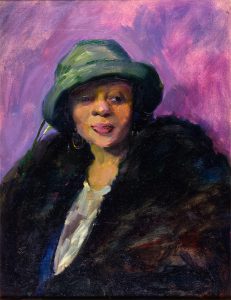Augustus Dunbier was born on a farm between Shelby and Osceola in Polk County, Nebraska and lived most of his life in Omaha, Nebraska where he became well-established as a portrait painter and private teacher. He was one of early Nebraska’s most successful and influential artists. His training was at Germany’s Dusseldorf Academy where he learned to paint in the “dark manner” of the old masters. During his developing years, Impressionism was fast becoming the “advanced” style and Dunbier’s natural love of color moved him to adopt the Impressionist manner. Upon returning to America, Dunbier spent some time painting with other “Nebraska artists” Robert Spencer and Robert Henri. Spencer is generally recognized as a technically orthodox impressionist painter, and Henri is known more for the vigorous realism of the Ashcan School. These artists seem to have reinforced Dunbier’s fear of the tyranny of style and helped him determine to go his own way.
While Dunbier made his living primarily as a portrait painter, his favorite subject was landscape. While studying at the Art Institute of Chicago, Dunbier met Walter Ufer who persuaded Gus to join him in Taos in the summer of 1916. Eventually Dunbier became friends with all the Taos artists, especially Ufer and Eanger I. Couse. The Southwest landscape impressed Dunbier strongly and he returned there seasonally for the rest of his life. It was the Nebraska countryside that most attracted Dunbier, however.
After color, Gus’ next sacred thing was the out-of-doors. Painting in “plein aire” was vitally important and Dunbier almost always would create his works after dragging all his equipment up to a bluff overlooking the Missouri River or out to his artist friend Robert Gilder’s home “Wake Robin.” Because of his desire to capture his subject at a specific moment, he applied his paint vigorously and quickly and usually finished a canvas within a few hours. His motive was to capture the intangibles of season, temperature, time of day, atmospheric light, and impending weather. This is evident in the differences between the landscapes painted in various locations. His Nebraska landscapes and those painted in New England and Alaska tend to be more tonal and convey a sense of a more liquid air. Those created in New Mexico and Arizona concentrate on the intense value contrasts created by the light in those locales.
Dunbier’s career from 1915 to 1977 was one of the longest uninterrupted art careers of any Nebraska painter and he was an important teacher to his peers and the next generation of Nebraska artists. One can still see the influences of Augustus Dunbier in the work of many Nebraska painters today. He died on September 11, 1977 at age 89 in Omaha.










